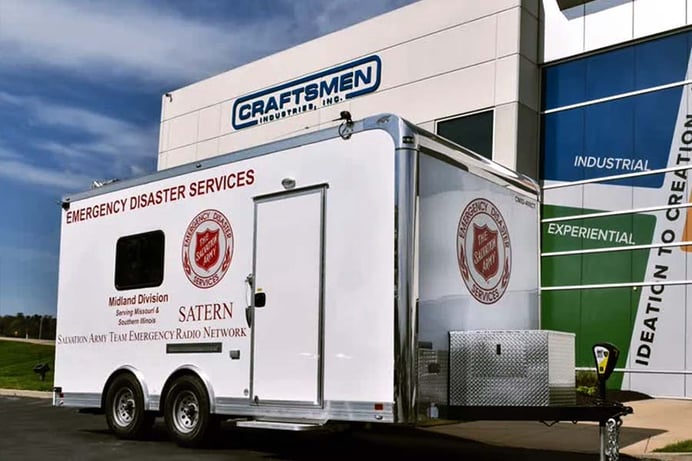5 Benefits of Mobile Command Centers
Mobile command centers fill a critical need in our country and around the world because they are uniquely able to serve as a base of operations in...
3 min read
Craftsmen Industries Feb 21, 2024 5:28:56 PM

Mobile command centers are crucial vehicles in emergencies and natural disasters. Besides providing a fast response to emergencies, mobile command centers allow emergency responders to monitor and surveil the affected areas. But how are mobile command centers used for surveillance?
This is precisely what we are going to explore below. So keep reading to see how mobile command centers may help your team when dispatched.

Source: craftsmenind.com
A mobile command center is a vehicle equipped with sophisticated technology, communication systems, and incident management and surveillance facilities. Mobile command units include standalone trailers or containers.
Mobile command centers are used for surveillance purposes for:
The surveillance capabilities of mobile command units are crucial in gathering real-time information about incidents or operations. They allow you to take control and coordinate your team wherever your help is needed.
At Craftsmen, we equip your command center trailers with advanced surveillance and monitoring technology to gather that information. Our dedicated engineering team can design, engineer, and fabricate a command center according to your needs.
Craftsmen ensure that each mobile command center vehicle we design meets the strict environmental and HAZMAT qualifications and guidelines.
Mobile command centers are equipped with the following features and equipment.
For mobile command unit vehicles to be able to surveil, they require the proper surveillance and monitoring equipment. With state-of-the-art surveillance and monitoring equipment, your teams can collect information in real-time.
The collected information offers a comprehensive incident assessment, enabling responders to make informed decisions and divide resources. The high-tech equipment includes:
During disaster relief operations or effectively handling incident response, communication is vital. Seamless integration of such systems ensures effective communication between all teams.
You may enhance your team's coordination and operational efficiency with seamless communication. This is why mobile command centers are equipped with various communication systems, such as the following:
Mobile command units are crucial in surveillance operations and tracking missions. As such, they need management systems to handle the collected data.
We equip all command centers with robust information management systems that allow you to collect, analyze, and disseminate vital data. The data and information management systems may include:
Seamless integration of these management systems ensures a comprehensive understanding of the situation and effective facilitation of resource allocation.
When you dispatch your team, you want to optimize their effectiveness. This is why mobile command centers' interior design includes ergonomic considerations. These units' interior layout and design must emphasize functionality, accessibility, and user comfort.
Features that contribute to a cohesive working environment, especially during prolonged operations, include:

Source: craftsmenind.com
Because mobile command centers are often dispatched in remote areas hit by disasters (natural or otherwise), they need self-contained power units. Command centers may operate by themselves by having self-contained power and utility systems.
These systems ensure uninterrupted power supply to the command center equipment, communication systems, etc, regardless of whether external power sources are available or not. Self-contained utility and power systems usually include the following:
Mobile command units play a crucial role in the effective response of frontline officials. Various government and emergency agencies use mobile command unit vehicles.
Command centers are incredibly beneficial for emergency first responders such as:
Mobile command centers enable first responders to coordinate response efforts during accidents and large-scale emergencies.
Different government agencies may benefit from command centers, like those responsible for:
Mobile command units enable these government agencies to manage incidents and security operations. Government agencies may protect public safety and health by deploying mobile command centers.
Environmental agencies and scientific research organizations may use mobile command units in their fieldwork. This includes field research, data collection, and monitoring in remote or challenging environments.
Command centers are beneficial for health agencies because of their self-contained power sources. They are also useful as they have the facilities to transport medical equipment to remote areas.
Health agencies use mobile medical units during health emergencies, vaccination campaigns, and pandemics. With a mobile command center, emergency responders may coordinate
A fast response is crucial in emergencies. First responders must deploy resources quickly to the affected areas to prevent further damage and manage the situation. For this purpose, a mobile command center offers emergency teams a centralized hub for coordination, communication, and command.
Command centers are deployed in response to natural disasters and emergencies, including:

Source: craftsmenind.com
How are mobile command centers used for surveillance? Mobile command centers are equipped with state-of-the-art technology, communication systems, and incident management facilities. This allows emergency agencies to surveil affected areas.
Many health and safety agencies may benefit greatly from investing in self-powered mobile command centers.

Mobile command centers fill a critical need in our country and around the world because they are uniquely able to serve as a base of operations in...

In terms of emergency response, every second counts. During times like natural disasters and rescue operations, command centers have a crucial role...

MCCs have a variety of use cases that help different agencies in many ways. They are vehicles that primarily help with managing and coordinating...